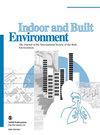Energy and economic performance optimization of a window with variable transparency shape-stabilized PCM in hot summer and cold winter climate zone
IF 2.9
3区 工程技术
Q2 CONSTRUCTION & BUILDING TECHNOLOGY
引用次数: 0
Abstract
Improving the thermal performance of windows is important for building energy efficiency. Filling windows with variable transparency shape-stabilized phase change materials (VTSS-PCM) improves the thermal inertia of windows while avoiding the leakage of PCM. In this paper, a new type of VTSS-PCM window was proposed, tested, simulated and optimized in hot summer and cold winter climate zone. A numerical model of the VTSS-PCM window was built, and the model was validated using experimental tests. On this basis, three key parameters of VTSS-PCM were investigated and optimized. Finally, the energy and economic performance of the optimized VTSS-PCM window were compared with a typical hollow glass window. The results showed that the total annual unfavourable heat transfer (TAHT) and the annual investment cost (AIC) of the VTSS-PCM window obtained from the optimization were 118.16 kWh/m优化夏热冬冷气候区可变透明度形状稳定 PCM 窗的能源和经济性能
提高窗户的热性能对建筑节能非常重要。在窗户中填充可变透明度形状稳定相变材料(VTSS-PCM)可提高窗户的热惯性,同时避免 PCM 的泄漏。本文提出了一种新型 VTSS-PCM 窗,并在夏热冬冷气候区进行了测试、模拟和优化。建立了 VTSS-PCM 窗的数值模型,并通过实验测试对模型进行了验证。在此基础上,对 VTSS-PCM 的三个关键参数进行了研究和优化。最后,将优化后的 VTSS-PCM 窗的能源和经济性能与典型的中空玻璃窗进行了比较。结果表明,优化后的 VTSS-PCM 窗的年总不利传热系数(TAHT)和年投资成本(AIC)分别为 118.16 kWh/m2 和 8.53 元人民币/m2。与中空玻璃窗相比,VTSS-PCM 窗的 TAHT 降低了 30.14%,年总成本降低了 28.39%。VTSS-PCM 窗在节能性能和经济性能方面都具有更好的发展潜力。该研究为 VTSS-PCM 窗在中国夏热冬冷地区的应用提供了参考。
本文章由计算机程序翻译,如有差异,请以英文原文为准。
求助全文
约1分钟内获得全文
求助全文
来源期刊

Indoor and Built Environment
环境科学-工程:环境
CiteScore
6.40
自引率
25.00%
发文量
130
审稿时长
2.6 months
期刊介绍:
Indoor and Built Environment publishes reports on any topic pertaining to the quality of the indoor and built environment, and how these might effect the health, performance, efficiency and comfort of persons living or working there. Topics range from urban infrastructure, design of buildings, and materials used to laboratory studies including building airflow simulations and health effects. This journal is a member of the Committee on Publication Ethics (COPE).
 求助内容:
求助内容: 应助结果提醒方式:
应助结果提醒方式:


